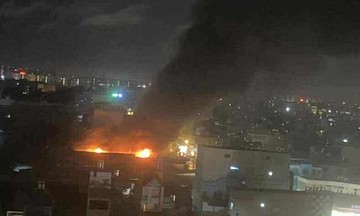On the afternoon of 18/7, the Ministry of Agriculture and Rural Development held a meeting to respond to Typhoon Wipha, even though the storm is still far from the East Sea. Mai Van Khiem, Director of the National Center for Hydro-Meteorological Forecasting, said the storm currently has winds of level 8-9, with gusts of 11. Satellite images show convective cloud swirls have appeared around the eye of the storm – a sign that Wipha will strengthen in the next few days.
Khiem said that Typhoon Wipha's path is quite similar to that of Typhoon Yagi in 2024. When entering the East Sea, the storm will encounter four favorable conditions for rapid intensification: high sea surface temperature (29-31 degrees Celsius), large ocean heat flux, weak wind shear, and upper-level wind divergence. However, two factors will restrain Wipha from intensifying as rapidly as Yagi: its projected path may deviate further north, and the ocean humidity is lower. "Despite this, we still need to be aware of the possibility of the storm making landfall with winds of level 10-11 and gusts of 14-15," Khiem said.
 |
Mai Van Khiem gives his assessment of Typhoon Wipha. Photo: Gia Chinh |
Mai Van Khiem gives his assessment of Typhoon Wipha. Photo: Gia Chinh
Currently, international meteorological stations are still offering different scenarios, with a path deviation of up to 100 km, so the specific impact on Vietnam is still unclear. When the storm enters the East Sea, domestic meteorological agencies will have more data to make more accurate forecasts.
The Border Guard Command has announced that it has informed and counted more than 35,100 vessels with over 147,300 workers at sea. No ships are operating in the northeast of the North East Sea – the dangerous area according to the forecast.
Avoiding a repeat of the Thac Ba situation
At the meeting, Deputy Minister of Agriculture and Rural Development Nguyen Hoang Hiep noted that the northern region currently has 2,495 reservoirs, of which 137 are severely damaged and 47 are under construction. The average water storage is 59-85% of the design capacity, and many reservoirs are already at high levels, such as Son La and Lao Cai at 79%, Tuyen Quang at 73%, and Phu Tho at 75%. He asked the units to carefully calculate flood discharge plans to ensure the safety of dams and reservoirs, "avoiding a situation like the Thac Ba hydropower plant last year".
The provinces from Quang Ninh to Thanh Hoa currently have about 126,500 ha of aquaculture, including nearly 53,000 ha of brackish water shrimp, over 53,000 ha of mollusks, 21,500 ha of freshwater fish, nearly 19,000 cages and rafts, and about 3,700 watchtowers. Hiep asked local authorities to guide people to harvest early if possible, "to avoid the situation of people clinging to their property and staying to watch over cages and rafts when the storm comes, as happened during Typhoon Yagi".
He also noted that standing units need to closely coordinate with localities in the context of two-level government operations, clearly defining responsibilities and tasks when natural disasters occur.
 |
Forecast path and affected area of Typhoon Wipha at 1 PM on 18/7. Photo: Disaster Monitoring System |
Forecast path and affected area of Typhoon Wipha at 1 PM on 18/7. Photo: Disaster Monitoring System
Since the beginning of the year, there have been two storms in the East Sea. Typhoon Danas did not affect the mainland, while Typhoon Wutip in June did not make landfall but caused heavy rain from 11 to 13/6 in the central region. This flood caused 11 deaths in Quang Tri and Hue City, flooded over 3,500 houses, and affected 88,000 ha of crops. Many traffic routes were eroded and flooded; flights from Da Nang were delayed and canceled; and the Miss Universe final had to be postponed due to rising floodwaters on the Perfume River.
Typhoon Yagi – named by Japan – entered the East Sea on 1/9/2024 and was considered the strongest storm in 30 years in the East Sea and 70 years on the mainland of Vietnam. The storm made landfall in Quang Ninh at noon on 7/9 with winds of level 14, gusts of 17; Hai Duong recorded winds of level 11, Hanoi level 10. The storm maintained its strength on land for over 12 hours, causing 318 deaths and 26 missing persons, mostly due to landslides. The economic damage was over 83.7 trillion dong, equivalent to 0.62% of 2023 GDP and nearly equal to the total budget revenue of the midland and mountainous regions in the north in 2024.
Gia Chinh












